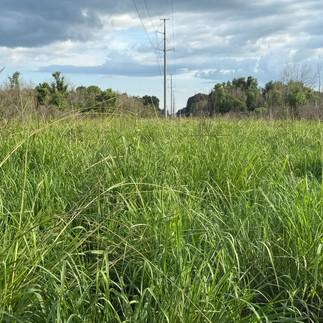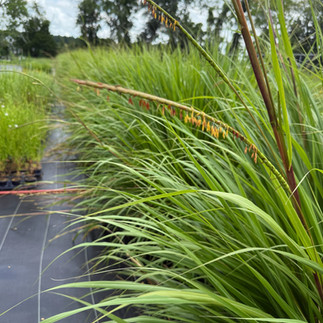Eastern Gamagrass: Grazing One of Louisiana's Most Palatable Native Grasses
- Louisiana GLCI
- 24 hours ago
- 3 min read
Updated: 11 minutes ago
Overview
Eastern Gamagrass (Tripsacum dactyloides) is a warm-season perennial bunch grass that is native to most of the Eastern US. Its native range extends from central Texas to southeastern Nebraska and central Iowa, east to the Atlantic Ocean. Eastern Gamagrass is a highly productive and palatable grass, and it does well in an intensively managed pasture. It also can thrive in moist soils with poor drainage, making it a good forage choice for much of Louisiana.

Distinct characteristics
Eastern Gamagrass has several distinct characteristics that help make it easy to identify.
Flat, long leaf blades
12-30 inches long and 0.4-1.2 inches wide
In late summer (July & August), brown stems come out and above the foliage, holding the seeds at the tip
It is strongly rooted with rhizomes, and this is also one of the ways it can reproduce and spread
A bunch grass, and a telltale characteristic is a bare spot in the middle of the circle of foliage
It has distinct seeds (some black and some blonde) in a straight row. Immature seeds look different and are green. Only the mature seeds at the end will slide off when touched. Black seeds generally germinate better, and are more fertile than blonde ones
It bears a striking resemblance to corn, especially with the immature seeds and their orange inflorescences. Eastern Gamagrass is a distant relative to corn
The leaves also look similar to corn plants, just narrower
Grazing Eastern Gamagrass
Compared to other native grasses, Eastern Gamagrass ranks in the top 4 as the most palatable forage option selected by cattle. It also has an average crude protein percentage of 12.5 at the boot stage. The boot stage is when the inflorescence is enclosed in the sheath of the uppermost leaf.
Due to its palatability, Gamagrass has the potential to be eliminated if grazed continuously, and consequently is missing from historically grazed prairies. It is recommended to graze Eastern Gamagrass in a short duration, high intensity rotation schedule. We suggest allowing for 30-45 days of rest between rotations to allow for the best recovery. Gamagrass regrowth is very tender and nutritious, which means livestock will heavily prefer this growth over other forages. This can lead to spot grazing, with the same plants being defoliated almost daily, which will eventually lead to plant death. According to NRCS, grazing Gamagrass must be controlled so that a minimum of 6-8 inches of stubble is left to maintain the stand, plant vigor, forage yield, and quality.
Benefits and Management from the Experts
Stuart Gardner, cattle farmer and state NRCS Rangeland Specialist, planted Eastern Gamagrass on his farm 20 years ago, and has been grazing it ever since. He said he purposefully chose the lowest and poorest draining paddocks to start growing on. Eastern Gamagrass along with switchgrass, another of the top 4 native bunch grasses, favor heavier soils and wetter conditions than most other native perennial warm-season grasses.
Due to its extensive deep root system, Eastern Gamagrass can reduce soil erosion, as well as survive drought conditions. Stuart said that during the 2023 drought, his Gamagrass paddocks were some of the only green things left on his farm. He said he was able to still get about 80% of a normal production year out of all of his Eastern Gamagrass paddocks.
Every three years, Stuart said he does a controlled burn on his Gamagrass paddocks. This practice helps to control unwanted woody and broad-leaf plants and stimulates new growth. He recommends pushing controlled burns back as late into the spring as you can. He said this allows for the most grass recovery with the least amount of broad-leaf recurrence.
Larry Allain has multiple succession-planted prairies on his farm in South Louisiana. He collects mature seed from his Gamagrass to add it to his native seed mix. To harvest the seeds, Larry said that once they’re mature, the last 1-2 seeds on the seedhead will just fall off into your hand. Hand collecting seeds this way is tedious, and Larry walks his plantings in the evening and places the collected seeds in a plastic milk jug hung from his belt. Eastern Gamagrass seeds broadcast in the fall and early winter germinate readily and, under ideal conditions, self-seed and spread on their own.
Larry advocates for including other native grasses and forbs when planting Eastern Gama. Based on his research and experience, he has found, generally, that diverse grasslands produce more forage and are more resilient to drought and other problems. Diverse grasslands provide grazing animals with more food choices and takes some of the grazing pressure off of Eastern Gama.
To learn more about Louisiana Native Plant Species, this database contains information for over 1,700 plants. Each plant can be searched by scientific name, common name, and characteristics.
NRCS Article referenced: https://plants.usda.gov/DocumentLibrary/plantguide/pdf/pg_trda3.pdf


































Comentarios